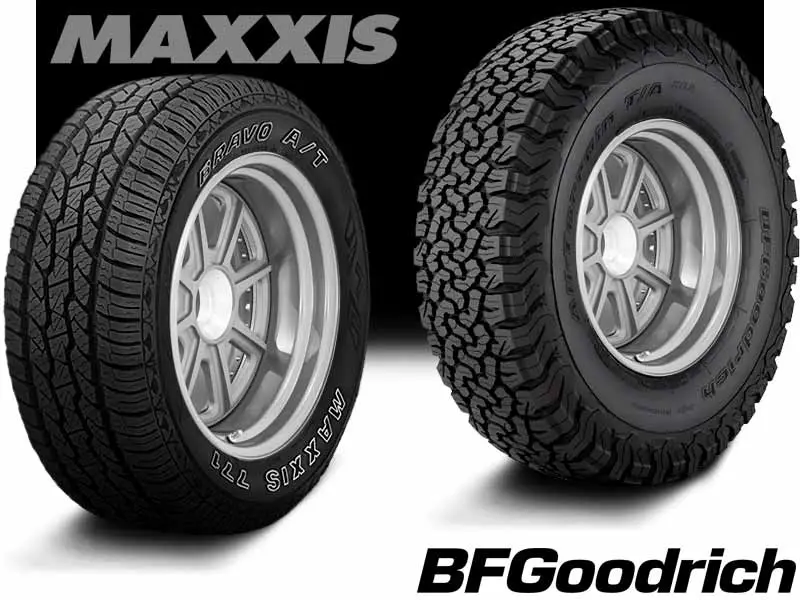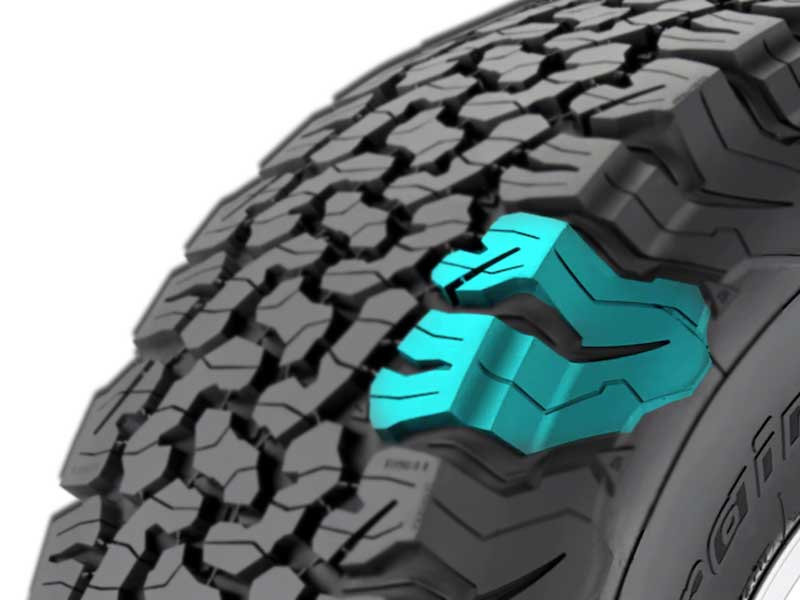Both the BF Goodrich KO2 and the Maxxis Bravo 771 are all terrain tires providing decent on and off road performance capabilities. They provide you with aggressive lugs which cut through the off road terrain very efficiently.
But can Maxxis all terrain outperform the famous tire by BF Goodrich? Well the key lies in their designs. So let’s start with that.

But first, lets check out the tire sizes, and their specs.
| Dimensions | Maxxis All Terrain 711 | BF Goodrich KO2 |
|---|---|---|
| Diameter (inches) | 15-20 | 15-22 |
| Speed Ratings | S, T, H | R, S, Q |
| Load Ratings | XL, C, D, E | C, E |
| Weight Range (lbs) | 28-74 | 35-67 |
| Tread Depth (32″/in) | 12-16 | 15 (except for 4 sizes) |
| UTQG | 500 A B | 500 A B |
| Winter Ratings | M+S, no 3PMSF | M+S & 3PMSF |
| Warranty | No mileage warranty | 50k miles |
Table of Contents
Tread Appearance
Starting things off with Maxxis Bravo, the tire resembles the tread of Toyo AT2 a lot. Where it features S shaped blocks in the middle divided in half.

The two blocks that surround on sides, make deep notches facing the lateral spacing between the tire’s shoulder blocks.
All blocks make 4 longitudinal channels, where the outer 2 are although wider, still not as aggressive as the zigzag ones in the middle.
Furthermore, all lugs have numerous wave like siping, along with sharp off-set edges and in-groove biters.
Moving towards the shoulders, they carry similar features, of siping, zigzag slits and all, and their outer margins are serrated, though they don’t make proper traction scoops. You can say each lug is staggered on itself.
On the other side, the good old BF Goodrich KO2 provides 3 blocks in the middle, forming an interlocking pattern with their hook shaped designs.

All these lugs have full depth sipes, off-set edges and notches, which produce much greater bite in comparison.
Though most of the tire’s “bite” comes form its aggressive shoulders.
They have widest of all lateral grooves, and in them, have bold stone ejectors.
The tire actually feature two of these ejectors, where the other ones (triangularly shaped) are placed in the circumferential grooves following these shoulder lugs).
So you get a very self cleaning tread. Note that the Bravo AT 771 doesn’t come with any.
Moreover, these shoulder lugs are staggered with thick mud scoops (unlike the Maxxis tire), and they join up to form thicker sidewall lugs.
Dry Traction
The dry traction is two parts. Longitudinal and lateral traction.
The longitudinal grip depends on central lugs of the tread (in terms of how well they connect with the road while on highways). While the lateral or sideways grip depends on shoulder lugs, as they bear the most weight, when the tire corners, forming a firmer road-rubber contact.
And in both scenarios the Maxxis All Terrain 771 is taking the lead.
The tire with continuous running central most rib (having Z shaped lugs) supply you with shorter braking distances, on average (a metric which directly calculated directional grip).
Moreover, with such packed up shoulders, the tire also features superior handling capabilities. Whereas on BF Goodrich KO2 with such voided structure of those shoulders, its not surprising to see this tire lacking here overall to its counterpart.
Though the definitely surprising thing about KO2 is its steering response. It offers you with better under and over steering balance, relatively. But why is that?
Well, this has to do with the tire’s overall lighter structure, and stiffer rubber composition. This accounts for smaller amount of lug flexing as the tire corners, resulting in a more direct steering, even with such aggressive tread pattern.
Wet traction
In terms of wet performance, the Maxxis All Terrain 771 comes out a little better, but only when the tire is new.
What I mean by that is, it’s sipes aren’t full depth, so with wear, they go away.
Sipes are basically slits in the tread, which soak up water particles, so you can say, these offer majority of overall wet grip.
So although the BF Goodrich KO2 comes out with stiffer rubber, which restrict its sipes to properly flex, to create suction for water particles coming underneath, at least they last as the tire wears.
So you still get better performance on this tire nonetheless, even though its nothing to be proud off.
Though still if wet traction is your major concern, you should avoid getting both of these tires. You can go for some other A/T options, such as the Falken Wildpeak AT3w, or the Sumitomo Encounter A/T, instead.
Tread Life
Despite both tires coming with a similar treadwear rating of 500 (UTQG), the BF Goodrich KO2 stands out in terms of supplying overall longer tread life. And this can be explained by looking at the tire’s 3 main variables, tread depth, rubber composition, and overall weight.
While both tires give you 3-ply sidewalls, the BFG KO2 distinguishes itself with its notably lighter structure, still. And this reduced weight basically don’t put as much force/pressure on the lugs as the rub against the road, leading to a slower rate of tread erosion over time.
Moreover, the tire’s superior tread life is also due to its harder rubber compound, which is more resistant to rapid wear.
And so even though it’s overall tread depth on average is shallower, compared to its counterpart, it still takes longer to reach down to the depth of replacement levels (which is by the way, 2/32″).
This explains why the BFG KO2 confidently offers a warranty for up to 50,000 miles, while Maxxis doesn’t provide any.
Fuel Economy
Fuel efficiency is intrinsically tied to a tire’s rolling resistance, which is primarily determined by the tire’s weight and tread pattern, combined.
That’s why even though Maxxis 771 gets to be heavier out of the two, both tires still show up with similar fuel economy, relatively.
Basically, on Maxxis A/T, as the tire’s tread design consist of longitudinally arranged ribs, you get a very streamlined structure, which rolls over the road without too many restrictions.
So KO2 with lighter weight, and stiffer compound (which don’t cause a lot of lug bending), only gets to offer as much fuel efficiency as the Maxxis 771.
Off-Road Performance
Off-road traction is seen better overall on BF Goodrich KO2, and I know you saw this coming.
The tire although features similar 3 ply sidewalls, or you can say durability, it simply carries a lot more biting ability, along with a self cleaning tread compared to its counterpart.
So on all terrain types it excels by a big margin. Let’s analyze them one after another.
On Mud
On muddy terrains, the KO2’s interlocking lugs design with wider tread voids, simply allow mud multiple channels to leave out form all sides, while its thick mud scoops on its staggered shoulders act as paddles, throwing mud backwards, generating forward moving inertia.
The Maxxis 711 with longitudinally arranged ribs, don’t allow mud to leave out sideways, and its missing traction scoops are also not helping either.
Rocky Terrains
On rocky terrains, when it comes to gravely roads, again the BF Goodrich KO2 with its dual stone ejectors, don’t allow sharp stones to get lodged in to the tread, which could hurt the rubber, and limit overall handling capabilities. While it’s stiffer rubber composition with greater Kevlar, account for greater chip resistance (to the rubber).
And here, the Maxxis A/T lacks with it’s missing stone ejectors.
When it comes to climbing rocks, the BF Goodrich KO2 with it’s hook shaped blocks simply supply grip in all longitudinal and lateral angles. And that grip gets further enhanced, thanks to tries full depth sipes, which allows lugs to get split open (according to the surface).
The Maxxis 771 on the other hand, doesn’t offer as much gripping efficacy with its directional orientation of lugs, and its sipes are also not full depth either.
Moreover, this tire is also missing with good enough sidewall lugs, so with lowered air pressure, they can’t offer extra footprint to meet with the rocky surface. Though the good thing about this tire is, at least it offer 3 ply sidewalls, so you get puncture resistance on the most puncturing terrain out there.
Sandy Terrains
On sand, you need to avoid digging. And so here again, the BF Goodrich KO2 is taking the lead with it’s tread’s better floating properties.
As already seen, it features a lighter overall structure, comparatively, so that means its less prone to sinking in the soft sand.
Moreover, with its sidewall lugs covering such a large surface area, they get to enhance overall footprint with the sand with lowered air pressure. And this further lowers the overall tire’s density.
Maxxis AT on the other hand, although features a softer compound, which molds better with the sand upon reducing air pressure, its sharper sides, along with heavier weight, still renders it lower in overall performance compared to KO2.
To Sum Up
Let me summarize everything we have discussed so far, above.
Even though the BF Goodrich KO2 is a more aggressive option, its dry traction is still better overall, thanks to its superior steering responsiveness (which comes from its lighter structure).
Though, when it comes to wet traction, both tires exhibit comparable performance, where neither outshines the other, at-least not noticeably.
Same goes when it comes to fuel economy, both the KO2 and Bravo 771 perform on par, though the KO2 does take the lead in terms of tread life, primarily due to its tougher rubber composition.
But main difference, nonetheless, is still seen off-road, where KO2 takes the lead by a huge margin.
It excels in muddy and gravely terrains, with its superior self cleaning grooves, with dual stone ejectors.
And on rocks, it’s interlocking lug design supply tremendous grip in all directions.
And on sand, you get sidewall lugs, which spread out, enhancing overall footprint and floating with reduced air pressure.